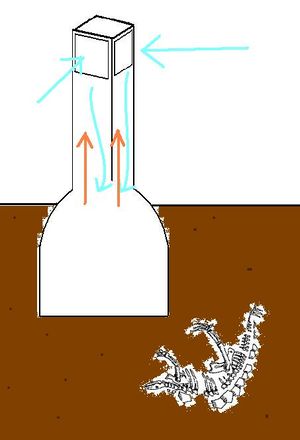Refrigeration: Difference between revisions
No edit summary |
|||
| Line 13: | Line 13: | ||
[[File:Concept for fridge.JPG|thumb|300px|center|The top of the tower is high above the ground, where air is cooler and wind is faster. The wind catching in the sail turns the mouth of the tower to face into the wind, in the same manner as a weathercock. This wind goes down into the underground pit and cools it. During hot weather, the pit is cooled by the thermal storage of the earth. Hot air rises out of the tower. Food stored in the pit would need little to no energy to keep it refrigerated.]] | [[File:Concept for fridge.JPG|thumb|300px|center|The top of the tower is high above the ground, where air is cooler and wind is faster. The wind catching in the sail turns the mouth of the tower to face into the wind, in the same manner as a weathercock. This wind goes down into the underground pit and cools it. During hot weather, the pit is cooled by the thermal storage of the earth. Hot air rises out of the tower. Food stored in the pit would need little to no energy to keep it refrigerated.]] | ||
== | ==Fridge efficiency methods== | ||
fullness: If a fridge has more space it thus has more air to cool to keep food below room temperature, So keeping space occupied in a fridge leads to energy savings. | fullness: If a fridge has more space it thus has more air to cool to keep food below room temperature, So keeping space occupied in a fridge leads to energy savings. | ||
Shape: Simply put it should be a box with a lid that holds the cold air in when it opened like a deep-freeze. | Shape: Simply put it should be a box with a lid that holds the cold air in when it opened like a deep-freeze. | ||
| Line 19: | Line 19: | ||
As the [[Earthships]] manual points out, it is wasteful to put a fridge in a heated room (as most homes do). If you want to keep the fridge cool, allow it access to cool outside air. | As the [[Earthships]] manual points out, it is wasteful to put a fridge in a heated room (as most homes do). If you want to keep the fridge cool, allow it access to cool outside air. | ||
==Converting a freezer to a high-efficiency fridge== | |||
Se the links below for an open-source method to convert a chest freezer into a fridge. The fridge will run on 150 Watt-hours per day (equivalent to running a laptop for 2 hours) compared to 1500 Watt hours, which is the average in the USA according to [http://www.eia.doe.gov/emeu/reps/enduse/er01_us.html this]. | |||
The converted fridge yields a lifetime of service, so we can modify/fabricate with a basic CNC mill. | |||
*http://blog.holyscraphotsprings.com/2010/09/chest-freezer-to-fridge-conversion-1900.html | |||
*http://www.aselfsufficientlife.com/chest-freezer-to-fridge-conversion-the-most-energy-efficient-fridge-ever.html | |||
*[http://www.amazon.com/gp/product/B0002EAL58?ie=UTF8&tag=selfsufficientlife-20&linkCode=as2&camp=1789&creative=390957&creativeASIN=B0002EAL58 | |||
* http://mtbest.net/chest_fridge.html | |||
[[Image:freezertofridge.jpg]] | |||
==Sundanzer== | |||
According to Abe at Velacreations, his Sundanzer uses 50 Watt hours per day, but it is a small refrigerator. It was $800 direct from the factory (it had a cosmetic blemish). The lifetime is 20 years+, pretty much like any fridge or freezer. It is a chest fridge, extra insulation, very efficient. You can get them in freezer models as well. | |||
Revision as of 16:43, 15 February 2011
Main > Food and Agriculture > Food Storage and Processing
Einstein fridge
Albert Einstein invented a refrigerator with no moving parts. It is powered by applying heat to one of the chambers; no electricity is required. The expired patent gives basic plans of how it works. This should be developed into a full open-source design with building instructions, bill of materials etc. It fulfils all the criteria for an Open Ecology product: it is in the public domain, it should last a lifetime and be cheap to build, it would be extremely useful to an off-grid community, it could help alleviate poverty .
Thermal mass fridge
Described in Volume III of the Earthship manual. Basically uses the coolness of the earth in summer to keep cool.
Persian windcatchers
A windcatcher is a tower rising up to catch high winds and funnel them down into an area to be cooled. Simultaneously, it acts as a chimney letting hot air rise out.
Concept for combined thermal mass/ windcatcher system

Fridge efficiency methods
fullness: If a fridge has more space it thus has more air to cool to keep food below room temperature, So keeping space occupied in a fridge leads to energy savings. Shape: Simply put it should be a box with a lid that holds the cold air in when it opened like a deep-freeze. [1]
As the Earthships manual points out, it is wasteful to put a fridge in a heated room (as most homes do). If you want to keep the fridge cool, allow it access to cool outside air.
Converting a freezer to a high-efficiency fridge
Se the links below for an open-source method to convert a chest freezer into a fridge. The fridge will run on 150 Watt-hours per day (equivalent to running a laptop for 2 hours) compared to 1500 Watt hours, which is the average in the USA according to this.
The converted fridge yields a lifetime of service, so we can modify/fabricate with a basic CNC mill.
- http://blog.holyscraphotsprings.com/2010/09/chest-freezer-to-fridge-conversion-1900.html
- http://www.aselfsufficientlife.com/chest-freezer-to-fridge-conversion-the-most-energy-efficient-fridge-ever.html
- [http://www.amazon.com/gp/product/B0002EAL58?ie=UTF8&tag=selfsufficientlife-20&linkCode=as2&camp=1789&creative=390957&creativeASIN=B0002EAL58
- http://mtbest.net/chest_fridge.html
Sundanzer
According to Abe at Velacreations, his Sundanzer uses 50 Watt hours per day, but it is a small refrigerator. It was $800 direct from the factory (it had a cosmetic blemish). The lifetime is 20 years+, pretty much like any fridge or freezer. It is a chest fridge, extra insulation, very efficient. You can get them in freezer models as well.

